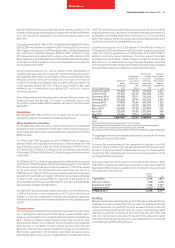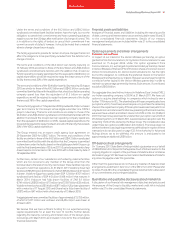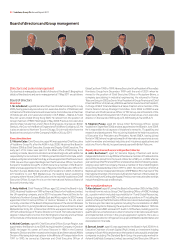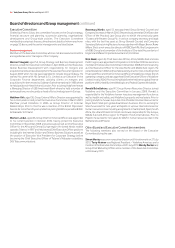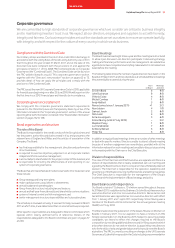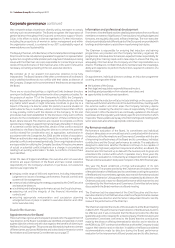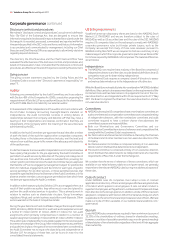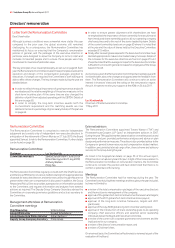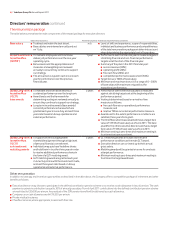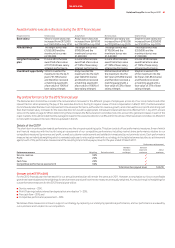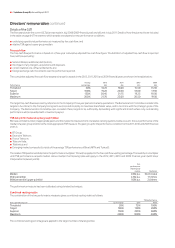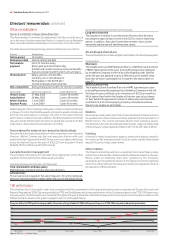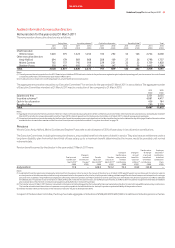Vodafone 2011 Annual Report Download - page 61
Download and view the complete annual report
Please find page 61 of the 2011 Vodafone annual report below. You can navigate through the pages in the report by either clicking on the pages listed below, or by using the keyword search tool below to find specific information within the annual report.
Vodafone Group Plc Annual Report 2011 59
Governance
substantive resolutions at our AGMs are decided on a poll. The poll is
conducted by our registrars and scrutinised by Electoral Reform Services.
The proxy votes cast in relation to all resolutions, including details of votes
withheld, are disclosed to those in attendance at the meeting and the results
of the poll are published on our website and announced via the Regulatory
News Service. Financial and other information is made available on our
website (www.vodafone.com/investor) which is regularly updated.
A summary of our share and control structures is set out on pages 135 and
136 in the shareholder information section of this report.
Political donations
The directors consider that it is in the best interest of shareholders that we
participate in public debate and opinion forming on matters which affect our
business. In order not to inhibit these activities and to avoid inadvertent
infringement of the Companies Act 2006, at the 2008 AGM the directors
sought and received shareholders’ approval for the Company and its
subsidiaries to be authorised, for the purposes of part 14 of the Companies
Act 2006, to make political donations and to incur political expenditure
during the period from the AGM to the conclusion of the AGM for the 2012
financial year or 29 July 2012, whichever is earlier, up to a maximum
aggregate amount of £100,000 per year. Neither the Company nor any of its
subsidiaries have made any such political donations during the year. It is our
Group policy not to make political donations or incur political expenditure
as those expressions are normally understood.
Internal control
The Board has overall responsibility for the system of internal control.
A sound system of internal control is designed to manage rather than
eliminate the risk of failure to achieve business objectives and can only
provide reasonable and not absolute assurance against material
misstatement or loss. The process of managing the risks associated with
social, environmental and ethical impacts is also discussed under
“Sustainable business” on pages 30 to 31.
The Board has established procedures that implement in full the Turnbull
Guidance “Internal Control: Revised Guidance for Directors on the Combined
Code” for the year under review and to the date of approval of the annual
report. These procedures, which are subject to regular review, provide an
ongoing process for identifying, evaluating and managing the significant
risks we face. See page 75 for management’s report on internal control over
financial reporting.
Monitoring and review activities
There are clear processes for monitoring the system of internal control and
reporting any significant control failings or weaknesses together with details
of corrective action. These include:
■ a formal annual confirmation provided by the Chief Executive and Chief
Financial Officer of each Group company certifying the operation of their
control systems and highlighting any weaknesses, the results of which
are reviewed by regional management, the Audit Committee and
the Board;
■ a review of the appropriateness of disclosures undertaken by the Chief
Executive and the Chief Financial Officer which includes formal annual
meetings with the Group’s Disclosure Committee; and
■ periodic examination of business processes on a risk basis including
reports on controls throughout the Group undertaken by the Group
internal audit department which reports directly to the Audit Committee.
In addition, we review any reports from the external auditor presented to the
Audit Committee and management relating to internal financial controls.
Any controls and procedures, no matter how well designed and operated,
can provide only reasonable and not absolute assurance of achieving the
desired control objectives. Management is required to apply judgement in
evaluating the risks we face in achieving our objectives, in determining the
risks that are considered acceptable to bear, in assessing the likelihood of
the risks concerned materialising, in identifying our ability to reduce the
incidence and impact on the business of risks that do materialise and in
ensuring that the costs of operating particular controls are proportionate to
the benefit.
Risk management
We have a Risk Council to manage the process of identifying, evaluating,
monitoring and mitigating risks. The Risk Council is chaired by the Chief
Financial Officer, facilitated by the Group Audit Director and attended by
representatives from the two geographic regions, finance and a cross
section of functions. Meeting twice a year, the Risk Council discusses and
reviews the risks identified by the senior management of the regions and
functions in their area of business. The risks are plotted on a “risk matrix” on
the basis of the likelihood of those risks occurring and the impact if they do
occur taking into consideration the action being taken to manage and
mitigate them. Those risk assessments are presented to the Executive
Committee and the Audit Committee which in turn report to the Board for
review and confirmation. The Group risks identified through this process are
included in “Principal risk factors and uncertainties” on pages 45 and 46. The
Risk Council ensures the ongoing review of risks to the business, the controls
in place to mitigate risks and identifies any further action required.
Risk mitigation
Although many risks remain outside of our direct control, a range of activities
are in place to mitigate the primary risks identified including those set out
on pages 45 to 46. A significant number of risks faced relate to the wider
operational and commercial affairs of the Group including those in relation
to competitor and regulator activity, the impact of technological
developments, the development of new products and services, the success
of cost reduction initiatives, the realisation of benefits from investments and
the potential reliance on certain suppliers. The responsibility for the Group’s
actions to address and mitigate these risks is either allocated to personnel
with direct functional responsibility for the matter or to operating company
and regional management with appropriate reporting and monitoring by the
Risk Council and Executive Committee. The size of the Group’s operations,
its geographical spread and its large and diverse customer base assist in
mitigating these risks.
A range of mitigations for other risks faced by the Group are also in place:
■ Macroeconomic, political and legal risks are considered by the Group’s
strategic planning process and as part of the Group’s processes for
capital allocation.
■ The Group has in place formal treasury policies that seek to ensure the
Group’s financing plans place appropriate weight on the risks arising from
volatile capital markets.
■ Where we do not have controlling interests in certain of our investments,
we work with our partners to maximise alignment of interests through the
development of mutually beneficial commercial outcomes and actively
involve ourselves in the governance of the company concerned.
■ The potential for health risks is comprehensively addressed through a
wide range of activities including the close monitoring of developments
in areas of science and technology and ensuring the devices sold meet all
necessary regulatory requirements including specific absorption rate
(‘SAR’) limits in relation to radio frequency emission and absorption.
■ We have invested significantly to minimise the risk of disruption of our
telecommunications services and have extensive business continuity
arrangements to mitigate the risks arising from a critical system failure.
Activity and progress on these matters are reported both into the Risk
Council and the Executive Committee.
Review of effectiveness
The Board and the Audit Committee have reviewed the effectiveness of the
internal control system including financial, operational and compliance
controls and risk management, in accordance with the Combined Code for
the period from 1 April 2010 to 17 May 2011 (the date of approval of our
annual report). No significant failings or weaknesses were identified during
this review. However, had there been any such failings or weaknesses,
the Board confirms that necessary actions would have been taken to
remedy them.


